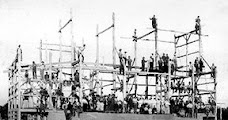Wednesday February 12, 2014 It is time for all the heroes to go home
if they have any, time for all of us common ones
to locate ourselves by the real things
we live by. -William Stafford I hear this over and over again in my classes and it's time to say it out loud: when we talk about leadership, we don't need another hero! I wonder: · Why is it that leadership is synonymous with heroism? · Why is it that when we hear the word "leader" many of us think about the heroic white male on a horse leading us into battle? · Why is it that we continue to rely on someone else to figure things out for us? This idea is so pervasive in the leadership discourse: the "pornography of leadership"—the seduction of someone taking charge, the charm, the women (or the men), the beautiful car, the great office, the big house… We keep believing and acting like this fairy tale is true. We need leadership, we say, and that means someone who will make it all better. Someone with vision, know-how. Someone who is trustworthy. And even though the models of command-and-control are well behind us, we continue to willingly surrender our individual freedom in exchange for security. Sometime I think that this is the most important job of the leadership development work: convincing people that in the times we live it is impossible to rely on one person to deal with the complex challenges we face. And when that job is done, what is left of the idea of leadership itself? Maybe we should embrace or look for a new word, like Mintzberg attempted a few years ago when he proclaimed that we need more "communityship" and less leadership to mobilize and move us into real, meaningful, collective change. The interesting part of this dilemma— besides the creation of a disempowering dependency that is contrary to the principle of a mature democracy— is its inconsistency with today's world. If leaders have the answers, why don't people just do what they say? Why do we talk about the "end of leadership" on one hand while we continue to feed the myth of the omnipotent leader on the other? The work in leadership development starts by questioning our desire for heroes. Are heroes born leaders, responsible for us? Are they authorities, rather than leaders, to whom we need to submit in exchange for security? This hero-myth is so persistent that I often ask the classical question in class: are leaders born or made? "Born where?" answered a student of mine from Mali once, dismissing with a simple question an entire branch of leadership studies and powerfully restating the simple idea that no man is an island. Indeed, no leader is an island; most are products of their communities. · What if leadership is an output rather than an input in a situation? · What if we start seeing leadership as an emergent phenomenon that manifests itself in the power of people working towards a collective purpose with passionate responsibility? · How does this idea change the conversation on leadership in our organizations and in our teaching? Good luck and check our new website www.leadersh1p.com | ![]()
![]()
![]()
![]()
![]()

